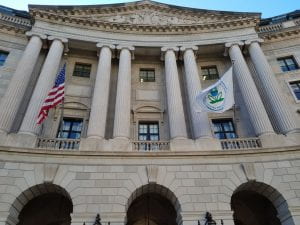Established in the wake of the first Earth Day, the Environmental Protection Agency is also 50 this year. Today, the agency appears regularly in the news as a poster-child for President Trump’s regulatory rollbacks. I have researched the EPA for over a decade, including following the Trump EPA with fascination. What have I learned?
I have learned that when EPA takes its mission seriously, it makes progress protecting environmental and human health. Notable successes include reducing smog, acid rain, and lead exposure, and banning many dangerous pesticides [1].
Yet I have also learned that, not only are these issues ongoing, but EPA tends to downplay chemical harms, even in the wake of an avalanche of scientific findings and public awareness of the enormity of environmental change and long-term, cumulative health effects for humans and wildlife. EPA has always used a less-protective, risk-based approach that insists on certainty about harms before taking protective measures. Throughout its history, EPA has been influenced by corporate science-for-hire that highlights and even purposefully produces scientific uncertainty [2]. Also, EPA has not been good at addressing disproportionate harms. For example, my research showed that EPA’s approach to controlling exposure to the neurotoxin mercury was to tell pregnant women to eat less of certain kinds of fish; this makes women of color (who on average eat more fish) responsible for their own exposures while letting polluters (coal-fired power plants) off the hook [3]. A signature success of the Obama EPA was a rule finally requiring power plants to reduce their mercury emissions.
I have learned that the Trump EPA has assaulted protections from many angles [4]. For example, it found the Obama-era mercury controls to be inappropriate; repealed the Clean Power Plan; and decided against proposed bans of several deadly solvents.
Yet I have also learned that the Trump EPA does this not by disregarding science, but by producing deregulatory science. In particular, it has developed new approaches to scientific risk analysis that compel the agency to disregard many benefits of regulation, highlight its costs, dismiss many scientific studies as inadequate, and fail to evaluate many real-world exposures to chemicals (such as using them without protective gear). It justifies these moves using ideas of scientific transparency, reproducibility, and evidence-based decision-making.
A key lesson of fifty years of the Environmental Protection Agency is that when it comes to environmental protection, it is not enough to ask, “Is it science?” It is also crucial to investigate the values and interests that influence scientific judgment. Is evidence being produced and evaluated through the lens of protecting the fossil fuel and petrochemical industries and the interests of the powerful, or through the lens of being most protective to environmental and human health?
Professor of Geography,
Ohio State University
[1] https://www.epa.gov/history
[2] On regulatory science at EPA, see e.g. Sheila Jasanoff, The Fifth Branch (1990, Harvard University Press). On tactics of corporate science, see e.g. Kristin Shrader-Frechette, Taking Action, Saving Lives (2007, Oxford University Press).
[3] Becky Mansfield, Environmental health as biosecurity: “seafood choices,” risk, and the pregnant woman as threshold. Annals of the Association of American Geographers 102(5): 969-976. 2012.
[4] These findings are in an unpublished manuscript and were presented at the 2020 Dimensions of Political Ecology conference.
